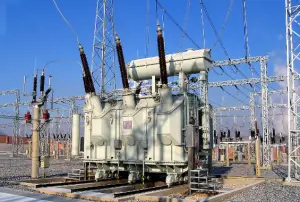Power transformer and distribution transformer are two types of transformer. Both transformers have different features. In this article, we will learn the difference between power and distribution transformer.
Contents
show
The main difference between power transformer and distribution transformer is that power transformer operates during load period whereas distribution transformer operates in both load and no-load period.
Let us see the difference between the two in detail.
Difference between Power transformer and Distribution transformer
| Power transformer | Distribution transformer |
| These transformers are used in generating stations and substations. | These transformers are used in distribution stations for supplying power to domestic and industrial loads. |
| It steps up voltages in generating stations and steps down voltages in substations. | It only steps down voltages. |
| It has a large size as compared to the distribution transformer. | It is smaller in size as compared to the power transformer. |
| These transformers operate only during load periods. | These transformers operate during load and no-load periods. |
| It is disconnected during the light load periods. | It is not disconnected during the light load periods. |
| It operates few hours a day. | It operates 24 hours a day. |
| It always operates at full load conditions. | It operates at a load less than full load. |
| It is designed with higher leakage reactance. | It is designed with small leakage reactance. |
| Voltage regulation is less important. | It has good voltage regulation. |
| The load fluctuations are very less in the power transformer. | The load fluctuations are more in the distribution transformer. |
| The flux density is higher in the power transformer. | The flux density is lower in the distribution transformer as compared to the power transformer. |
| It has a rating above 200 MVA. | It has a rating below 200 MVA. |
| It is designed to have maximum efficiency near 100%. | It has maximum efficiency between 50% to 70%. |
| Here Efficiency is calculated as the ratio of output to input power. | Here All day Efficiency is calculated as the load varies throughout a day. |
What is a distribution transformer?
- It is used to step down the distribution voltage to a level suitable for utilization purposes at the consumer’s premises.
- Distribution Transformer has its secondary terminals directly connected to the consumer’s terminal.
- They remain in operation all 24 hours a day.
- Distribution Transformers have good voltage regulation.
- Distribution Transformers have a small value of leakage reactance.
- They are designed to have a very low value of core loss.

What is a power transformer?
- They are used in generating stations or substations.
- It is used for step up or step down the voltage level.
- Power Transformer secondary terminals do not directly connect to the consumer’s terminal.
- They do not remain in operation all 24 hours a day. They operated during load periods and disconnected during light load periods.
- Power Transformers have maximum efficiency at or near full load.
- Power Transformers have greater leakage reactance.

